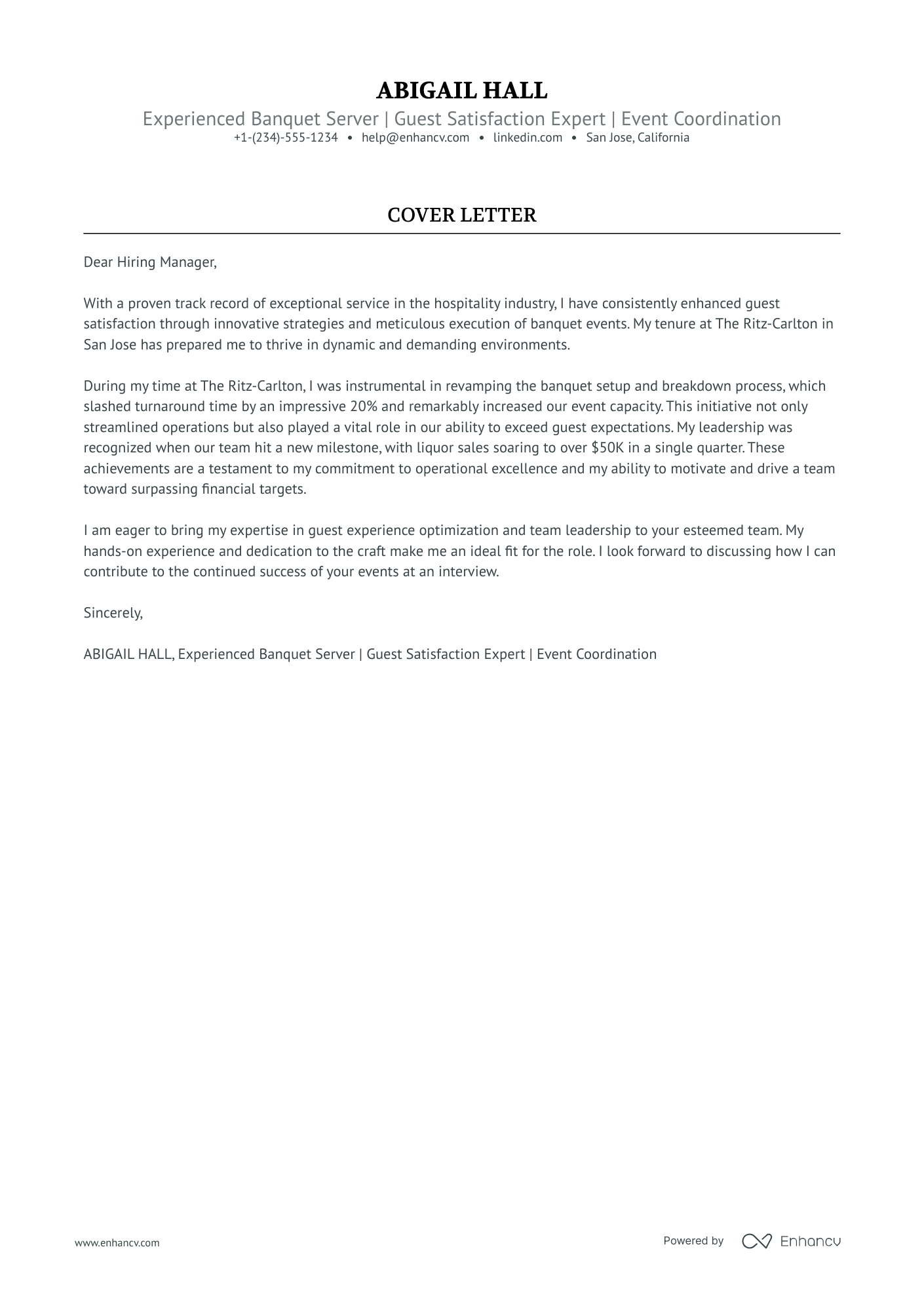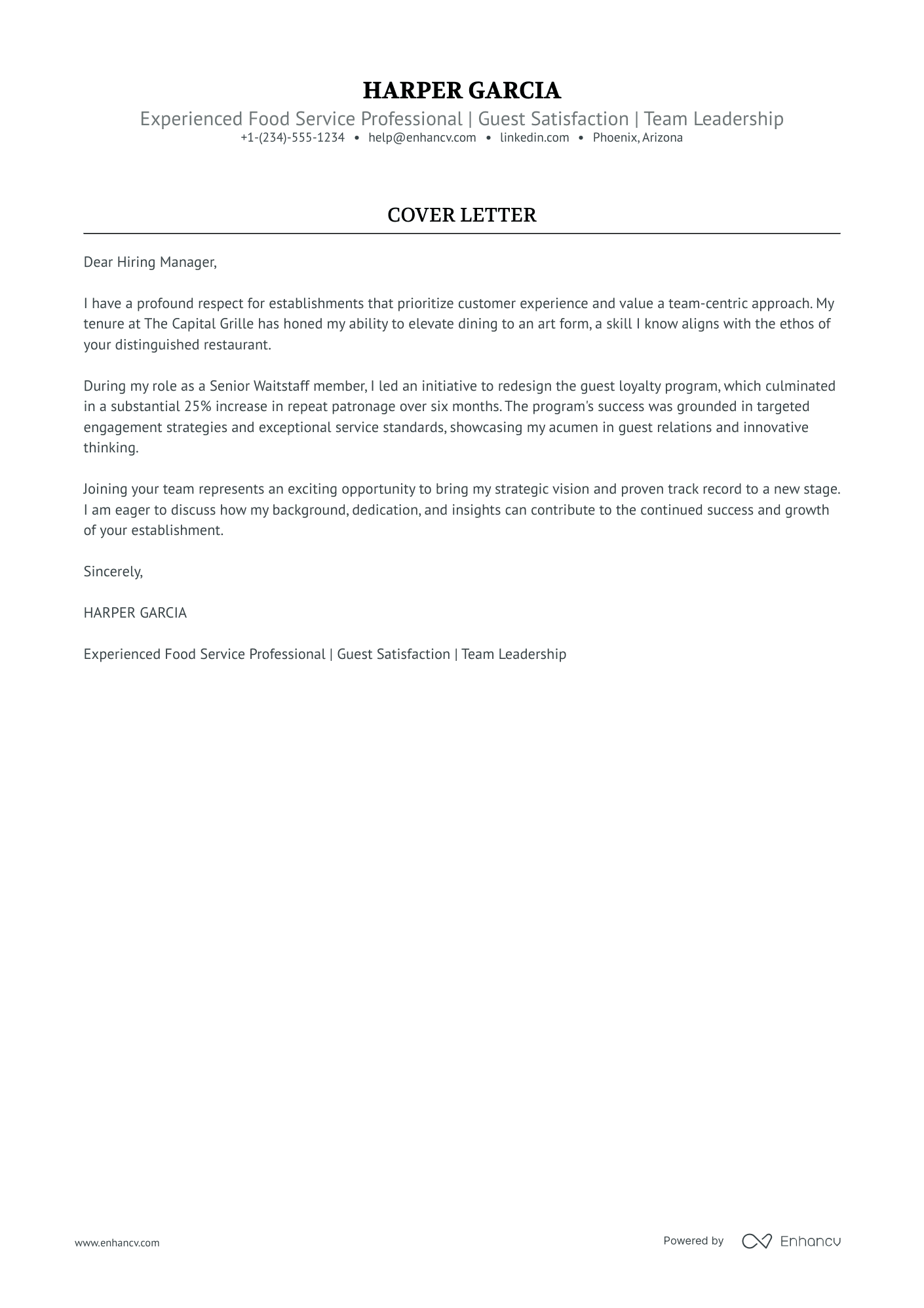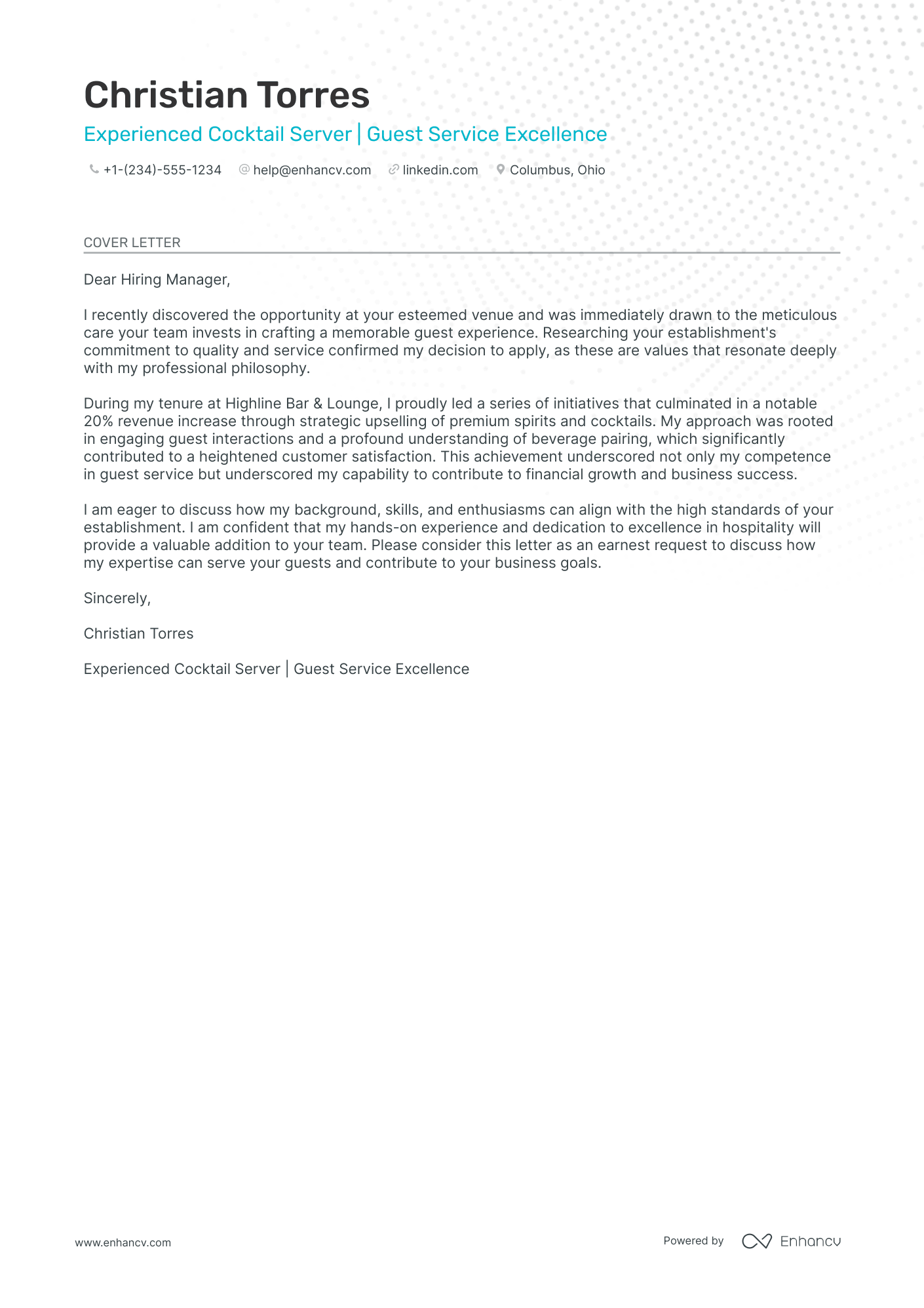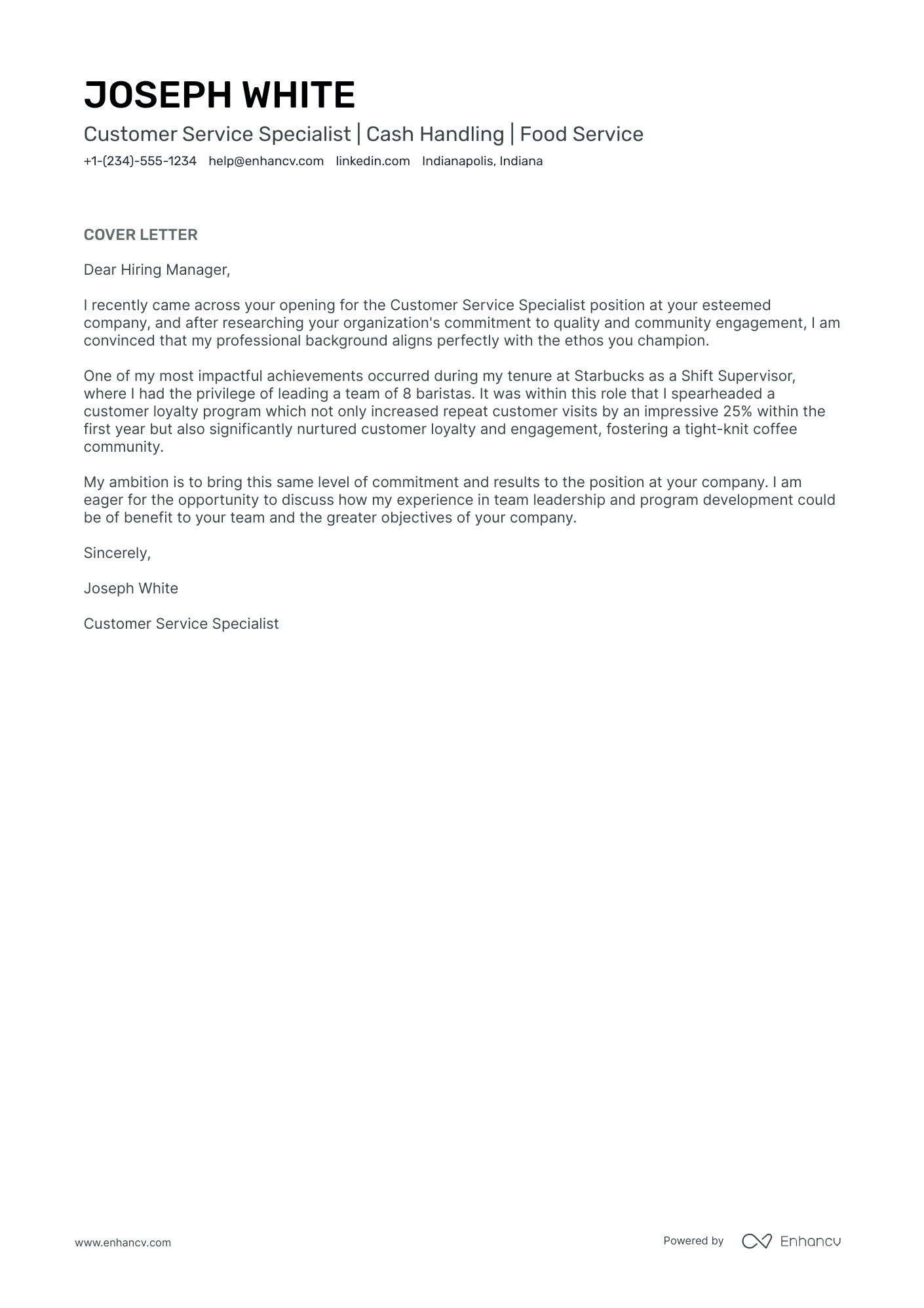Drafting a server cover letter can often feel like a daunting task, especially if you're already deep into job hunting. You know it's not just a repeat of your resume, yet you might struggle with highlighting your star moment without slipping into clichés. The key is to weave your proudest professional achievement into a compelling, formal narrative on a single page. Let's simplify the process and create a cover letter that stands out, just like your service.
- Writing the essential server cover letter sections: balancing your professionalism and personality;
- Mixing storytelling, your unique skill set, and your greatest achievement;
- Providing relevant (and interesting) information with your server cover letter, despite your lack of professional experience;
- Finding the perfect format for your[ server cover letter, using templates from industry experts.
Leverage the power of Enhancv's AI: upload your resume and our platform will map out how your server cover letter should look, in mere moments.
If the server isn't exactly the one you're looking for we have a plethora of cover letter examples for jobs like this one:
- Server resume guide and example
- McDonalds cover letter example
- Fast Food cover letter example
- Fine Dining Server cover letter example
- Cook cover letter example
- Lead Server cover letter example
- Dishwasher cover letter example
- Fine Dining Bartender cover letter example
- Catering Server cover letter example
- Line Cook cover letter example
- Bar Manager cover letter example
Drop your resume here or choose a file.
PDF & DOCX only. Max 2MB file size.
Server cover letter example
Taylor Foster
Clemson, SC
+1-(234)-555-1234
help@enhancv.com
- Emphasizing direct industry experience: The cover letter highlights the candidate's six years of experience as a Restaurant Server, demonstrating a track record in the role and a deep understanding of what excellence in service entails.
- Quantifiable achievements: By mentioning specific sales figures and the implementation of strategies that led to a measurable increase in sales, the candidate showcases a results-driven mentality, which is essential to thriving in a sales and service-oriented role.
- Ability to work under pressure: Reference to managing multiple tables and servicing a high volume of clients during peak hours shows the candidate can handle a fast-paced and high-stress environment, which is crucial for a busy restaurant setting.
- Teamwork and collaboration: The applicant mentions working effectively with managers to implement strategies that increased sales, indicating strong interpersonal and team collaboration skills that are necessary for a restaurant staff member to possess.
The visual appeal of your server cover letter: format, font, and structure
When using our cover letter builder, make sure to include these vital sections:
- Header (with your name, contact details, the role, and date);
- Greeting (that's personalized to the recruiter);
- Introductory paragraph (to capture attention);
- Body paragraph (to tell a story of how you've obtained your job-crucial skills);
- Closing paragraph (ending with a nod to the future ahead);
- Signature (that is not a must).
Our cover letter templates are already set up for you with the best server cover letter design with single-spaced paragraphs and a one-inch margin.
As for the font of your server cover letter, use the same one as you did in your resume (where modern and simple fonts, like Rubik and Bitter, take precedence over Arial and Times New Roman).
Your server cover letter is created with the recruiters in mind - as no Applicant Tracker System looks over this part of your profile.
When sending over your server cover letter, download it in PDF. This format allows your information and design to stay intact and to keep the same visual quality.
Not enough hours in the day? Try our free cover letter generator and get a polished letter in seconds.
The top sections on a server cover letter
- Header (including contact information): This should clearly display your name, address, phone number, and email so the recruiter can easily contact you for an interview or further discussion about the server position.
- Greeting: Address the hiring manager or restaurant owner directly (if possible) to create a personal connection and show that you have researched who is in charge of hiring.
- Introduction: Briefly introduce yourself, mentioning your enthusiasm for the server role and any relevant experience in the hospitality or restaurant industry to immediately convey your suitability for the job.
- Body of the letter (Experience and Skills): Outline your specific server skills, such as knowledge of menu items, ability to handle busy shifts, and customer service experience, as well as any accolades or recognition you’ve received in past roles, to demonstrate your ability to excel in the position.
- Closing and Call to Action: Conclude with a strong closing statement that reiterates your interest in the position and includes a polite call to action, encouraging the hiring manager to schedule an interview or to review your attached resume for more details on your qualifications.
Key qualities recruiters search for in a candidate’s cover letter
Previous experience in a fast-paced dining establishment: Recruiters look for candidates with proven ability to handle the demands of a busy restaurant environment efficiently.
Excellent customer service skills: Being a server requires constant interaction with guests, so the ability to provide a high level of service and ensure customer satisfaction is essential.
Strong memory and attention to detail: A good server must remember customers' orders, preferences, and any special requests, as well as being attentive to the timing and details of service.
Teamwork and collaboration: Servers often work with kitchen staff, hosts, and other servers, so the ability to work well within a team is crucial for a smooth restaurant operation.
Flexibility and adaptability: Being open to working various shifts, including nights, weekends, and holidays, as well as adapting to different service styles or menu changes is important in this role.
Physical stamina and dexterity: The job of a server is physically demanding, often requiring long hours on one's feet, carrying trays, and moving quickly around the dining area.
What greeting should you use in your server cover letter salutation
A simple "Hello" or "Hey" just won't work.
With your server cover letter salutation, you set the tone of the whole communication.
You should thus address the hiring managers by using their first (or last name) in your greeting.
But how do you find out who's recruiting for the role?
The easiest way is to look up the role on LinkedIn or the corporate website.
Alternatively, you could also contact the organization via social media or email, for more information.
Unable to still obtain the recruiter's name?
Don't go down the "To whom it may concern path". Instead, start your cover letter with a "Dear HR team".
List of salutations you can use
- Dear Hiring Manager,
- Dear [Employer's Name],
- Dear [Department] Team,
- Dear [Company Name] Recruiter,
- Dear Mr./Ms. [Last Name],
- Dear Search Committee,
Your server cover letter introduction and the value you bring
Moving on from the "Dear Recruiter" to your professional introduction.
Use those first two sentences of your server cover letter to present the biggest asset you'd bring to the organization.
Don't go into too much detail about your achievement or the skill set, but instead - go straight for the win.
That is - what is your value as a professional?
Would you be able to build stronger, professional relationships in any type of communication? Or, potentially, integrate seamlessly into the team?
Choosing your best achievement for the middle or body of your server cover letter
Now that you have the recruiters' attention, it's time to write the chunkiest bit of your server cover letter.
The body consists of three to six paragraphs that focus on one of your achievements.
Use your past success to tell a story of how you obtained your most job-crucial skills and know-how (make sure to back these up with tangible metrics).
Another excellent idea for your server cover letter's middle paragraphs is to shine a light on your unique professional value.
Write consistently and make sure to present information that is relevant to the role.
Thinking about the closing paragraph of your server cover letter
Before your signature, you have extra space to close off your server cover letter.
Use it to either make a promise or look to the future.
Remind recruiters how invaluable of a candidate you are by showing what you plan to achieve in the role.
Also, note your availability for a potential next meeting (in person or over the telephone).
By showing recruiters that you're thinking about the future, you'd come off as both interested in the opportunity and responsible.
Which story should you tell in your server cover letter when you have zero experience
Candidates, lacking professional experience in the field - this one is for you.
Your server cover letter is an exercise of integrity, honesty, and, above all, spinning a positive narrative around your strengths.
And what better way to capture recruiters' attention than with your most job-relevant achievement (this could be from your internship or volunteering experience)?
Make sure to back up your success with transferrable skills that are relevant to the job (e.g. how your year, studying abroad, has taught you to be more motivated and handle multicultural environments).
Another safe card you can bet on is your career dream: in the body of your server cover letter, go into the details of how your ambitions would help make the company you're applying for better.
Key takeaways
We hope this server cover letter writing guide has shown you how to:
- Format your server cover letter with the mandatory sections (e.g. header, greeting, intro, body, and closing) and select the right font (P.S. It should be the same as the one you've used for your resume);
- Substitute your lack of professional experience with your most noteworthy achievement, outside of work, or your dreams and passions;
- Ensure recruiters have a more personalized experience by tailoring your cover letter not just to the role, but to them (e.g. writing their first/last name in the salutation, etc.);
- Introducing your biggest achievement and the skills it has taught you in your server cover letter body;
- Write no more than two sentences in your server cover letter introduction to set the right tone from the get-go.
Server cover letter examples
By Experience
Senior Server
By Role
























